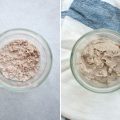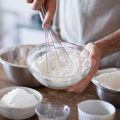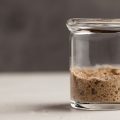Maintaining a warm environment for your sourdough starter is crucial to its success and ensuring those beautiful, tangy loaves of bread. As a living culture, your starter needs the right temperature to thrive and develop those delightful flavors. I will share some of the best tips to help you keep your sourdough starter warm throughout the fermentation process. Whether you’re a seasoned baker or just starting your sourdough journey, these tips will ensure your starter remains cozy and active, ready to create delectable bread every time. So let’s dive right in!
![How To Keep Sourdough Starter Warm [Best Tips And Why You Need To] 1 How to keep sourdough starter warm [best tips]](https://www.mydailysourdoughbread.com/wp-content/uploads/2023/07/active-sourdough-starter-in-a-jar-kept-in-warm-temperatures-720x405.jpg)
Table of Contents
- Does Sourdough Starter Need To Be Warm?
- What Is The Ideal Temperature For Sourdough Starter
- 20 Ways to Keep Your Sourdough Starter Warm
- What To Do If The Temperature of Sourdough Starter Is Cold?
- Sourdough Starter Warmth is Key
- FAQ’s
Does Sourdough Starter Need To Be Warm?
Yes, maintaining a warm temperature is essential for a sourdough starter to thrive and produce quality bread.
A sourdough starter is a living culture of wild yeast and beneficial bacteria, which require warmth to remain active and ferment the dough properly.
Without adequate warmth, the fermentation process slows down or even stops, affecting the rise and taste of the bread. Therefore, it is crucial to keep your sourdough starter warm to ensure its success.
Why Does a Sourdough Starter Need Warmth?
Sourdough starters require warmth for optimal fermentation, which is crucial for baking sourdough bread.
The warm temperature creates an ideal environment for the yeast and bacteria present in the starter to thrive and multiply. This promotes the fermentation process, where the yeast consumes the sugars in the dough and produces carbon dioxide, leading to a light and airy texture in the bread.
Additionally, warmth helps activate enzymes in the starter, breaking down complex carbohydrates into simpler sugars that the yeast can utilize. This process enhances the flavor and structure of the bread.
Maintaining a warm ambient temperature is essential for an active sourdough starter and ensures successful sourdough bread baking!
Why Keep Sourdough Starter Warm When It’s Cold?
- Warmer temperatures support fermentation: Yeast activity slows down in the cold, which can affect how your bread rises. Keeping your sourdough starter warm helps the yeast work efficiently, resulting in a better texture and rise in your bread.
- Activate microorganisms: Warmth encourages the growth of beneficial microorganisms like yeast and bacteria in your starter. These microorganisms break down sugars and create the distinct flavors of sourdough. By providing warmth, you help them thrive and produce delicious bread.
- Help new starters develop: If you have a new starter, warmth is crucial during the early stages. It helps establish a diverse microbial community, ensuring a healthy fermentation process and better baking results later on.
What Is The Ideal Temperature For Sourdough Starter
Since the ideal temperature range for a sourdough starter is between 75°F and 85°F, maintaining a warm temperature within this range is important for the activity of the sourdough cultures and the fermentation process necessary for baking bread.
Warmer temperatures are favorable for the growth and activity of the wild yeasts and lactobacilli bacteria present in the starter. They get to metabolize sugars in the dough better, producing carbon dioxide and organic acids. These are important in the rise, flavor, and texture of your sourdough bread.
To ensure the proper temperature, you can use a digital thermometer to monitor the internal temperature of your sourdough starter. This helps you gauge if it is within the desired range.
It is important to avoid cooler temperatures or exposing the starter to direct heat, as extreme temperature fluctuations can impact the fermentation process.
This helps provide optimal conditions for sourdough cultures to thrive, which results in successful bread baking.
How To Measure The Temperature of Sourdough Starter
To measure your sourdough starter’s temperature, you can follow these steps. Note that you will be using a digital thermometer and your starter jar:
- Prepare the starter jar: Ensure that your starter jar is clean and free from any debris or residue.
- Stir the starter: Gently stir the sourdough starter in the jar to ensure a uniform temperature throughout the mixture.
- Insert the thermometer: Take your digital thermometer and carefully insert the probe into the sourdough starter. Make sure the probe reaches the middle of the mixture for an accurate reading.
- Wait for the reading: Allow the thermometer a few moments to stabilize and display the temperature reading. Take note of the temperature shown on the digital display.
- Remove the thermometer: Once you have recorded the temperature, gently remove the thermometer from the starter jar, taking care not to disturb the mixture.
20 Ways to Keep Your Sourdough Starter Warm
When it’s cold outside, it’s important to keep your sourdough starter warm for successful bread baking. If the ambient temperature is too cold for your sourdough starter, there are several steps you can take to provide the necessary warmth and maintain an optimal environment for fermentation.
Follow these tips to ensure optimal fermentation and successful baking of your sourdough bread:
Oven Light On
Place your sourdough starter near the oven with the light turned on. The gentle heat generated by the light bulb provides a warm and consistent temperature that promotes fermentation.
Ensure the oven is off while using this method.
Warm Water
When feeding your sourdough starter, use warm water instead of cold water. Warm water helps maintain a cozy environment for the microorganisms in the starter, encouraging their activity and fermentation.
Seed Raising Pad
To keep your sourdough starter warm, you can utilize a seed-raising pad.
The seed-raising pad provides gentle and consistent heat, creating an ideal environment for your sourdough starter to thrive and ferment successfully. You can maintain a warm and cozy setting for your sourdough starter, supporting its growth and the production of delicious homemade bread.
Place the pad on a stable surface and position your sourdough starter jar on top of it. Set the pad to the optimum temperature, or adjust it as needed. Regularly monitor the temperature using a thermometer to ensure it remains within the desired range.
Heating Pad
By placing the sourdough starter jar on top of the heating pad, the gentle and regulated heat helps create a warm environment, promoting the growth and activity of the yeast and bacteria in the starter. This encourages the fermentation process, leading to better texture, rise, and flavor in the final baked bread.
The heating pad acts as a reliable tool to ensure the sourdough starter remains warm.
Yogurt Maker
The yogurt maker is another great tool to use for creating warm temperatures for your sourdough starter. It consists of an insulated container with a heating element and temperature controls, enabling you to manipulate the temperature of your starter when needed.
Place your starter jar inside the yogurt maker, ensuring that it is clean and set to the correct temperature. Close the yogurt maker and allow the starter to remain inside for the desired duration. Regularly monitor the temperature to ensure it stays correct.
The yogurt maker provides a controlled and consistent source of warmth, creating an optimal environment for the sourdough starter to thrive.
Instant Pot
The instant pot will create an ambient temperature for your sourdough starter.
Ensure it is clean and free from any residue, then place the glass jar containing the starter inside the instant pot, ensuring that it is stable and secure. Close the Instant Pot lid without engaging the pressure cooking function. Select the “Yogurt” setting and adjust the temperature to the “Normal” or “Medium” setting. Set the time for the minimum duration available, usually 8 hours.
Proofing Box
A proofing box serves the purpose of creating an ideal environment for the process of proofing or fermenting dough, including sourdough starters. Its main function is to provide consistent temperature and humidity levels.
By setting the desired temperature. It also optimizes conditions for yeast grown, enzyme activity and of course flavor development.
Place your sourdough starter jar inside the proofing box, ensuring it is stable and secure. Set the proofing box to the desired temperature. Close the proofing box and allow the starter to remain inside for the desired duration. Monitor the temperature regularly to maintain the optimal range for fermentation.
DIY Proofing Box
Create a DIY proofing box by placing your sourdough starter inside a container with a lid in a warm water bath. The warm water helps maintain a constant temperature around the starter, mimicking a controlled environment for sourdough fermentation, therefore resulting in a happy starter.
Up High
To keep your sourdough starter warm, you can place it up high in your kitchen.
Find a spot that is elevated and away from any drafts or cold surfaces. Placing the starter up high takes advantage of the warm air that naturally rises in a room. This can provide a slightly warmer temperature compared to lower areas.
Additionally, being elevated helps to avoid any cool drafts that may be present near the ground.
Cupboard or Draw Next to Oven
Another way to keep your sourdough starter warm is by placing it in a cupboard or drawer next to your oven. This location takes advantage of the ambient heat generated by the oven during baking.
Ensure that the cupboard or drawer is not too close to the oven, as excessive heat can harm the starter.
Microwave
While it is generally not recommended to place your sourdough starter in the microwave, you can use the microwave as a passive heat source.
The microwave acts as an enclosed space that can trap some ambient heat, similar to a cupboard or drawer.
Ensure the microwave is clean and turned off before placing your sourdough starter inside.
Sunny Window Sill
To keep your sourdough starter warm, you can place it on a sunny window sill. The sunlight provides natural warmth, creating a cozy environment for your starter.
Choose a window that receives ample sunlight throughout the day. Ensure the window sill is clean and away from any drafts. Keep an eye on the temperature to prevent overheating.
Electric Blanket
The electric blanket offers a consistent and gentle warmth that creates an optimal environment for fermentation.
Ensure the blanket is clean and placed in a dry area, before placing it on a stable surface to avoid any accidental spillage. Pop your sourdough starter atop the blanket, and let it do its thing!
Next To The Kettle
To keep your sourdough starter warm, you can place it next to a kettle. The kettle emits radiant heat during and after boiling, creating a warm environment suitable for the starter.
Position the starter jar in a safe spot adjacent to the kettle, ensuring it is not too close to avoid direct heat or potential damage. Be cautious and monitor the temperature regularly with a thermometer to prevent overheating.
In The Car
Placing your sourdough starter in the car can be an option to keep it warm, but caution must be exercised. The car’s interior can provide a relatively warm environment, especially on sunny days.
Ensure the sourdough starter jar is securely sealed to prevent spills. Choose a spot in the car that receives indirect sunlight or is away from direct heat sources.
Crock Pot or Slow Cooker
Consider using a slow cooker or crock pot to create a warm and stable environment for your sourdough starter.
Set the slow cooker to its lowest temperature setting or the “keep warm” function. Place your starter in a heatproof container inside the slow cooker, ensuring it is not in direct contact with the heating element.
Kombucha Jar Band
The insulating properties of the band help retain heat and create a warm environment for fermentation. It acts as a protective layer, maintaining a stable temperature for your starter. Additionally, the band can provide some insulation from temperature fluctuations in the surroundings.
Heat Packs
The heat pack releases consistent heat.
Activate the heat pack according to the manufacturer’s instructions and place it near your sourdough starter jar, ensuring it is not in direct contact.
Airing Cupboard
Position your sourdough starter jar securely inside the cupboard, ensuring it is away from any direct heat sources or potential drafts.
Fermentation Crock
The thick walls of the crock provide insulation and help maintain a stable temperature for fermentation.
Transfer your sourdough starter to the crock and ensure the lid is securely sealed. The crock creates a warm and protected environment, ideal for the growth of yeast and bacteria.
What To Do If The Temperature of Sourdough Starter Is Cold?
If your sourdough starter is too cold, there are several steps you can take to provide the necessary warmth for optimal fermentation, especially during cold weather.
- First, find a heat source in your kitchen or baking area. This could be an oven with a pilot light, a radiator, or any appliance that generates ambient heat. Place your sourdough starter near this heat source to benefit from the warmth it provides.
- You can also look for warm spots in your kitchen, such as on top of the refrigerator or near other appliances that emit heat. These areas naturally maintain higher temperatures and can help keep your sourdough starter warm.
- To provide insulation and retain heat, wrap your sourdough starter jar with a clean towel or place it inside a small insulated cooler. This extra layer of insulation helps trap warmth, keeping your starter at a suitable temperature for fermentation.
- Another effective method is to employ a warm water bath. Fill a larger container with warm water and place your sourdough starter jar inside. Ensure the water level stays below the rim of the jar. The warm water bath creates a gentle and consistent heat source, raising the temperature of the starter.
It’s important to monitor the temperature of your sourdough starter using a thermometer. Aim to keep it within the optimal range (if you recall, 75°F to 85°F) for proper fermentation. Adjust your chosen method accordingly to maintain a consistent and warm environment.
![How To Keep Sourdough Starter Warm [Best Tips And Why You Need To] 4 How to keep sourdough starter warm [best tips]](https://www.mydailysourdoughbread.com/wp-content/uploads/2023/07/warm-temperatures-contribute-to-sourdough-starter-health-720x405.jpg)
Sourdough Starter Warmth is Key
In conclusion, maintaining a warm environment for your sourdough starter is crucial for successful fermentation and bread baking.
By utilizing methods such as heat packs, insulation, warm spots, or specialized equipment like fermentation crocks or proofing boxes, you can ensure the optimum temperature.
FAQ’s
What Temperature Kills Sourdough Starter?
Extreme temperatures can be detrimental to sourdough starter. Temperatures above 120°F (49°C) can kill the beneficial microorganisms, while temperatures below 40°F (4°C) can cause the starter to go dormant.
What is The Ideal Temperature For Sourdough Starter?
The ideal temperature range for a sourdough starter is typically between 75°F and 85°F (24°C to 29°C).
Can I Keep My Sourdough Starter Warm In A Hot Water Tank?
It is not recommended to keep your sourdough starter in a hot water tank. While the hot water tank may provide warmth, it poses potential risks and is not a suitable environment for your starter. Hot water tanks are designed for heating water and are not meant to accommodate living organisms like sourdough starters. Placing your starter in a hot water tank can expose it to excessive heat, fluctuations, and harmful chemicals. It’s best to explore other methods, such as using a warm spot in your kitchen, insulation, or specialized equipment like proofing boxes or yogurt makers, to ensure a safe and controlled warm environment for your sourdough starter.

![How To Keep Sourdough Starter Warm [Best Tips And Why You Need To] 2 Thermopro tp03 digital meat thermometer for cooking kitchen food candy instant read thermometer with backlight and magnet for oil deep fry bbq grill smoker thermometer](https://m.media-amazon.com/images/I/4147s9RhYOL._SL500_.jpg)
![How To Keep Sourdough Starter Warm [Best Tips And Why You Need To] 3 Cornucopia kombucha jar cloth covers (4-pack); unbleached muslin cloth covers with rubber bands, custom size for kombucha jars](https://m.media-amazon.com/images/I/31tpfl2SoYL._SL500_.jpg)





